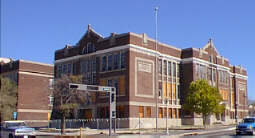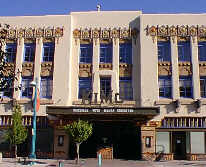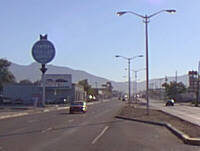Although some of the buildings along Central are very old, the street itself predates any of its structures that we can see today. Long before the Americans took over the New Mexican territory, back in the early days of the Spanish settlements along the Middle Rio Grande, travelers entered the area from the Estancia Valley to the east by way of the gap between the Sandia and Manzano mountain ranges, which they then referred to as Carnue Canyon and later called Tijeras Canyon. This dusty trail leading down to the river assumed more importance as Albuquerque slowly grew throughout the 1700s and 1800s. Merchants, immigrants, and even armies plodded along some of the same stretches that are often jammed with traffic today.
 |
The earliest known building along this road is still being used today. One of the adobe structures of the Manzano Day School, located just to the east of Old Town, was once La Glorieta, home of Manuel Armijo, governor of the state for Mexico in the 1830s and 1840s. Armijo fled to avoid the American occupation, but other leading citizens took up residence in the home. Franz Huning, a German immigrant who became the most successful local merchant in the mid-to-late nineteenth century, lived there before building Huning Castle, a splendidly ornate dwelling situated off the road not far from the present intersection with Laguna Boulevard and torn down in the 1950s. Huning's granddaughter, Erna Fergusson, who wrote books about Albuquerque and New Mexico, and who was probably the city's leading cultural spokesperson in the years after World War II, was born at La Glorieta.
When the railroad came through in 1880, the character of the main road and of the urban settlement was permanently changed. New Town, in which the Anglos soon outnumbered the Hispanics, sprang up around the railroad yards almost two miles to the east of the earlier settlement. That very first year, the most important of the streets were laid out, and the section of the principal thoroughfare, which went through New Albuquerque, was dubbed "Railroad Avenue." As commerce flourished along the main street, most of the new residences were built a block or two off Railroad Avenue.
In the early 1880s downtown Albuquerque along Railroad Avenue acted very much the heart of the bustling urban area. Mercantile businesses and hotels, barbershops, and saloons rapidly crowded in, their false fronts and painted-in upper windows giving them the air of a later-day movie set. Tracks for mule-drawn streetcars were laid over the dirt roadway, connecting New Albuquerque with the older town. Civic-minded enterprise coexisted alongside gambling and prostitution, and the energy and excitement of the district ran high. The commercial buildings from the railroad era have since passed away, but the railroad itself and Robinson Park, a triangular swatch of green between Eighth and Tenth Streets, remain as mementos of that heady time.
 |
As the town prospered, it spread out. The people built more substantial structures,
giving us tangible evidence to imagine what life was like for them. They began
to pave Railroad Avenue in the early 1890s. The University of New Mexico (UNM)
was established about a mile east of the railroad, and its administration was
housed in Hodgin Hall, a three-story, gabled, Victorian building completed in
1892. The streetcars were extended to the university, making possible the rapid
expansion of suburban residential areas. Ever since those years, the area around
the university has been one of the most thriving stretches of Central.
The first two decades of the new century brought Albuquerque's main street many new landmarks, and they also set in motion trends that have persisted to this day. Massive yet stylish masonry buildings went up in the core business district and in the area nearby; among them were the Hudson Hotel in 1905 (202 Central SE), the Rosenwald Building in 1910 (320 Central SW), and Albuquerque High School in 1914 (at the intersection with Broadway). These square-cornered structures seemed to maintain their dignity and strength even in years when their tenants were deserting them and their glass windows were being knocked out.
During much of the same time that these buildings were going up, the campus of UNM was being transformed. President William George Tight determined that Pueblo-style architecture was in keeping with the state's cultural heritage, and he directed a face-lifting of all the buildings, including Hodgin Hall. The ensuing controversy led to his ouster, but today the university's distinctive blend of pueblo and modern styles makes it one of the most attractive settings in the city. And between the university and the downtown came, in 1908, the Presbyterian Sanatorium, the first of many facilities to serve the growing influx of tuberculosis patients seeking the benefits of Albuquerque's healthful climate. It was the forerunner of the huge Presbyterian Hospital complex, which dominates several blocks of the neighborhood.
As a result of that early sanitarium and others, Railroad Avenue became popularly known as "TB Avenue." Wryly, the citizens were beginning to acknowledge that the railroad might not be the most important thing going on in town. In recognition of that street's emerging role as the backbone of Albuquerque, it was renamed Central Avenue in 1907.
 |
The 1920s, surely one of the most exciting decades in America's history, brought a number of striking new buildings to Central. Architectural developments in the downtown are and were particularly flamboyant. The Franciscan Hotel, described by some as "Pueblo Expressionist," went up in 1923, and the ornate KiMo Theater, with its abundance of Indian motifs, was erected three years later. The two tallest buildings in the city up until then, the First National Bank and the Sunshine Theater, came in 1922 and 1924. East of the downtown, at the intersection with Edith, the Albuquerque Public Library, one of the most graceful examples of the Pueblo style, was constructed in 1925. The streetcar company went out of business in 1928, but buses and increasingly numerous private automobiles kept the crowds on Central.
When the Great Depression struck, the money flowing through private enterprise slowed to a trickle. Business along Central Avenue that catered to the tourist trade suffered more than most. Nevertheless, government-supported construction continued. The Public Works Administration was responsible for the Albuquerque Little Theater at the corner of San Pasquale, near what was left of Franz Huning's estate, in 1936. Two years later and several miles to the east, the New Mexico State Fair was established with funds appropriated by the state legislature. Although fair time comes only in the fall, a huge flea market enlivens the grounds and that section of Central every Saturday and Sunday.
The pace of activity along the avenue picked up in the 1940s. Although the downtown segment continued to have the highest concentration of businesses and traffic, new structures were constantly going up to the east, giving that part of Central the beginnings of an elongated commercial strip. There were three principal reasons for this development. In the first place, Albuquerque was growing rapidly, and the downtown streets and business locations simply could not easily accommodate the swelling population as they had back when the town was small. Second, rebuilding the downtown so that it could handle many more people was more expensive and difficult than simply starting afresh on unoccupied land. And finally, most of the new residents were buying homes in the Heights, and they preferred to shop and be entertained near where they lived.
 |
The beginnings of this phenomenon were modest enough. In the early forties there were only two significant business centers in Albuquerque: the downtown core, where almost everything important was located, and a small cluster at the intersection of Central and Richmond, just east of UNM, which included the only bank and movie theater outside the downtown. Then in 1947 the developer R. G. Waggoman opened up Nob Hill, a U-shaped structure that constituted the city's first suburban shopping center, a few blocks to the east of the corner of Carlisle. Although skeptics called it "Waggoman's Folly" at first, it proved impressively successful. In rapid succession came the Highland Theater and neighboring stores, all further to the east, and the strip was well under way. As the 1940s gave way to the 1950s, other arterial streets, with their own commercial strips and neighborhood shopping centers, claimed more of the city's business, but East Central continued to reach out. And since it was not only the premier city street but also part of one of the nation's most important highways, it attracted a lavish sprinkling of inviting restaurants and gleaming motels.
 |
Although most of this new construction was commercial strip development, clustering
also took place, especially at the major intersections. The most significant
of these clusters was at the corner of San Mateo, where the 17-story First National
Bank Building opened to the public in 1963. A product of inexpensive construction,
this white monolith was adorned only by its name in green neon lights around
the top and lacked architectural distinction. Yet for a while it was the tallest
building in town, and, looking down on its gaudier but more transient neighbors,
it continues to dominate its part of the landscape. [First National Bank Building
is now called First Security Bank Building - ed.]
During the fifties and sixties - perhaps even to this day - new was constantly winning out over old. And new was what downtown Central Avenue was not. North and south of Central, where there was more room, new downtown buildings went up, but activity along what had been Albuquerque's most important street diminished. Decrepit buildings were torn down but seldom replaced; among the casualties were such landmarks as Huning Castle and the Franciscan Hotel. Meanwhile shoppers were taking their business elsewhere. The opening of the two regional shopping centers in the Northeast Heights, Winrock in 1961 and Coronado in 1963, hastened the decline. The completion of the interchange between the new I-40 and I-25 in 1966 reduced traffic not only through the downtown but on the whole length of Central. In the late 1960s and early 1970s, the city fathers considered routing downtown traffic around Central Avenue and converting that street into a pedestrian mall. Such a radical transformation was not accomplished, yet that stretch is now a relatively quiet but interesting two-lane street, a quaint shadow of its former self.
 |
The loss of the tourist trade and the constant rush of ever-newer locations began to hurt East Central as well. Most of the commercial establishments that went up during the boom days of the 1950s and 1960s were less substantial than the older downtown structures; hence they also faded faster. Scattered amongst still-flourishing restaurants are pornographic bookstores and movie houses; prostitutes mingle with commuters at bus stops. The old First National Bank Building at the intersection with San Mateo looks as monumental as ever, but less than a block away is a boarded up motel. Nevertheless, some of the old magic returns when the sun goes down. A spectacular display of neon signs bestows an exotic, unearthly glow on the street, giving it the air of a woman who has begun to age but whose charm is as alluring as ever.
As parts of Central Avenue have begun to go downhill, however, other sections have taken on the exuberance of youth. East of Wyoming Boulevard are mobile home dealers, second-hand stores, and expanses of vacant, ready-to-be-developed land. The traffic is thinner than in the old parts, but deals are closed and money changes hands with the same open enthusiasm that has always characterized the street. And on the west side of the Rio Grande, thanks to the recent population growth in the North and South Valleys and in the West Mesa, commercial activity is truly booming. The Hispanic influence is more pronounced along this stretch - the colors are bolder, low riders weave in and out of the traffic, and some of the signs are in Spanish. The abundance of supermarkets and discount stores indicates less affluence than on the eastern side. But the intense activity and high spirits of this section of the avenue are part of a tradition that goes back for more than a century.
One benchmark of the continuing revitalization of Central Avenue and Downtown was the purchase of the historic KiMo Theater by the city and its renovation, which began in 1978. The KiMo was rededicated and reopened as a public performance theater in 1982. The idea behind this renovations was that the arts and entertainment could be a driving force in the revitalization of Downtown and while the process was a slow one, the 1990s have seen a complete reversal in the use of the Downtown at night; there are numerous bars, discos and nightclubs catering to all tastes and ages including university students. Central Avenue is often as busy in the late evening as it is during the daytime when it serves the office population. These entertainment establishments are not the questionable establishments that appear in many deteriorated downtowns, but rather range from moderate to upscale with regard to costs and the clientele served. The daytime population is also being served by recently added fast-food outlets and coffee shops.
 |
A number of public and private buildings have also been added to the Downtown: e.g., the upscale Hyatt Hotel, the Alvarado Apartments (high-density housing), the expanded Albuquerque Convention Center, and a new federal courthouse, at Fourth and Lomas NW. Most remaining historic buildings are being utilized, and attractive public improvements have been added, such as the Fourth Street pedestrian mall, the Central Avenue streetscape improvements with its colorful light fixtures and landscaping, and the 1996 renovation of Civic Plaza. Included with these improvements is a series of public art projects including Glenna Goodacre's "Sidewalk Society" sculpture at Third and Tijeras, Tom Waldron's contemporary "Cone 10" sculpture at the Main Library, two murals adorning the New Mexico Mortgage Finance Authority building on Second Street at Gold - the projects of artist Joe Stephenson and youth participants from Working Classroom (a nonprofit arts agency providing art activities for economically disadvantaged youth) - and the Dr. Martin Luther King, Jr. Memorial across from the Convention Center at First and Dr. Martin Luther King, Jr. Boulevard (formerly Grand Avenue).
A major Central Avenue art project was the 1995-1996 addition of a series of artistic, concrete insets installed in the Central Avenue sidewalk that refer to architectural details of a number of historic Downtown buildings, including some that have been demolished. The insets were installed every 25 feet along Central between First and Eighth Streets. A brochure describes them and the historic vernacular architecture of Albuquerque's Downtown.
These efforts represent successful collaboration between the public and private sectors, including participation of the Downtown's City Center Council, the local merchants' promotion organization. Larger city growth patterns and the accompanying demographic changes are helping to re-energize the area. While the period between 1950 and 1990 brought much construction and growth in the Northeast Heights, geographical limitations there and available land on the west side have resulted in its rapid growth. These developments are pulling the geographic center of the city westward, and making Downtown, once again, the real center of the city. Values of Downtown properties, including housing, have increased remarkably, and occupation of rental housing there and in the rest of the city continues at approximately 97%.
Downtown growth and revitalization bring new challenges: new construction and "gentrification" need to be balanced with renovation and maintenance of older, surrounding neighborhoods. For example, expansion continues to the north around Lomas, to the south along Fourth in the community of Barelas, whose commercial center is being renovated, and east to Huning Highlands, where the old Albuquerque High School's preservation and possible reuse are still, at this writing, significant issues. Both high-density and low-income housing must be added in these areas, and additional retail opportunities developed.
(Up to Section II, Back to Central Avenue as an Alpha Street, On to Central Avenue - Object Lesson)